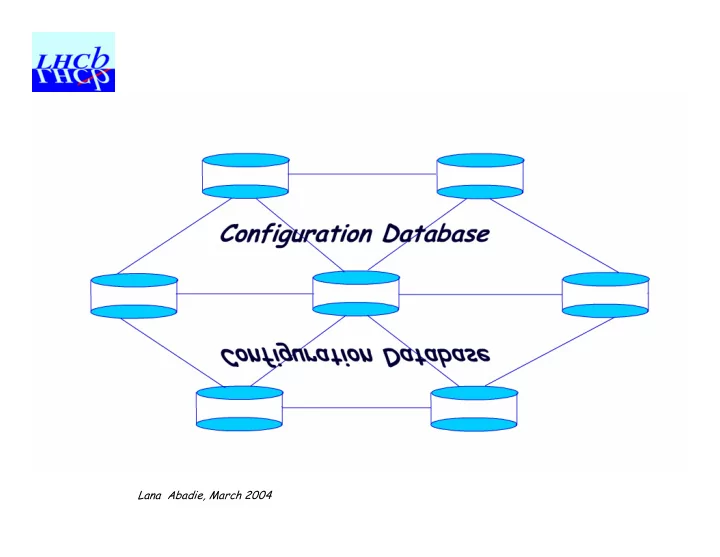

Lana Abadie, March 2004
Content • Objectives • DB Design Methodology – Readout network dataflow – Use cases – Entity relationship models – Table design • Conf.DB & PVSS (JCOP) • C routine example : use case 3 & 4 • Test Tool • Conclusion & future works
Objectives • Storage of all controllable devices from all sub- systems (electronics...) – static data (geographical position, links,...) – dynamic data (recipes, code to download...) • Each device will be stored in the Conf.DB and linked to its connectivity counterpart. • Implement tools: to populate, to configure, to maintain, to communicate with other existing tool such as PVSS.
DB Design Methodology 1. Dataflow of the system 2. Define the use cases (scenarios) 3. Build Entity relationship models 4. Design tables
ReadOutNetwork Data Flow FE cards ( L1FE) Multiplexing layer: 2 types of switch • 4 outputs(DAQ)+1(Throttle) • 2 types of traffic TRM (1 module) HLT (16 I /2 O) •HLT(1link) Level 1(16I/2O) ( HLTMS ) •Level 1 (up to 3) ( L1MS ) Ex:HLTMS_10 •Ex: VELO_L1FE00_00_00 Ex:L1MS_05 . HLT traffic Sorter Readout Network Switch RNS_Slot_00 RNS_Slot_15 Level 1 traffic ( RNS_Slot ) mixed traffic HLT possible link Level 1 possible link TFC system (readout supervisor) SFC SFC SFC SFC Storage System Switch Switch Switch Switch SFC_Switch CPU CPU CPU CPU SFC_Node CPU CPU CPU CPU CPU CPU CPU CPU CPU Farm
Use cases 1. Define the properties of a switch A switch has a type (L1MS for example) and a name (L1MS_05) and a hostname. Each switch type is characterized by a number of input and output ports. 2. Define the properties of a port 3. Find the adjacent switches (links) up or down connected to a given switch 4. Find all the connection paths between 2 devices 5. Check that a path exists between 2 extreme nodes (ie L1FE and SFC_node) 6. Retrieve all the links belonging to a given band link number and vice versa.
Path concept Example: I want to know all the possible connexion paths from VELO_L1FE00_00_00 to RNS_Slot which carries HLT Traffic. path 1: [(VELO_L1FE00_00_00, 2), (HLTMS_10, 4), HLT ] [(HLTMS_10,0),(RNS_Slot_03, 2), HLT ] → Selected path 2 : [(VELO_L1FE00_00_00, 3), (HLTMS_10, 8), HLT ] [(HLTMS_10,0),(RNS_Slot_03, 2), HLT ] → Selected path 3: [(VELO_L1FE00_00_00, 1), (L1MS_05, 5), L1 ] [L1MS_05,0),(RNS_Slot_11, 5), L1 ] → Not Selected path 4: [(VELO_L1FE00_00_00, 0), (L1MS_05, 1), L1 ] [L1MS_05,1),(RNS_Slot_11, 5), L1 ] → Not Selected first link second link RNS_Slot_11 VELO_L1FE00_00_00 0 0 1 0 5 L1MS_05 RNS_Slot Switch from 1 5 2 4 0 HLTMS_10 RNS_Slot_03 3 2 8 L1 traffic HLT Traffic
Entity relationship models Switch Type Switch Port has +Switch type +Switch Name + physical address +nbr of input ports +Switch type 1 n + switch name +nbr of output ports +Host name + nbr + input or output + RxFC (Enable or not) + TxFC (Enable or not) + status (Broken or not) + speed + Port Management(yes/no) Link + Wire sense (Switch/Switch, +LinkID Associaton : a link Switch/computer, Autosense) +Switch Name From has 2 ports + Phy: T, Sx, SL +Port Number From 1 will determine the 2 + Forced Speed (Yes/No) n +Switch Name To Band link 1 status of link +Port Number To +BandID +Type of link +LinkID n 1 Path +PathID +Link
Table Design Port + physical @ (pk) SwitchType + switch name (fk) +Switch type (pk) Switch List 1 n +nbr of input port ref Switch List(Switch_Name) +Switch Name (pk) 1 n +nbr of output port +Switch type (fk) + nbr ref SwitchType(Switch_type) + in_or_out +host name + RxFC (Enable or not) + TxFC (Enable or not) + status (Broken or not) Switch Connectivity + speed:(10,100)/(10,100,1000)/ +Switch_LinkID (pk) 1000/10.000 Mbit/s +Switch_From + Port Management(yes/no) 1 2 +Port_nbr_from + Wire sense (Switch/Switch, +Switch_to + Switch/computer, Autosense) +Port_nbr_to + Phy: T, Sx, SL Link Type +link_type (fk) ref Link Type(link nbr) + Forced Speed (Yes/No) 1 n +Link type + bidirectional_used Unique(switch name,nbr,in_or_out) +Link nbr (pk) + Unique(Switch_From, port_nbr_from) + Unique(Switch_to, port_nbr_to) Band Link + Switch_From, Port_nbr_from (fk) Link_id (fk) ref n<11 1 ref Port(switch name,nbr,in_or_out=‘out’) SwitchConnectivity(Switch_LinkID) + Switch_to, Port_nbr_to (fk) link_band_nbr (pk) ref Port(switch name,nbr,in_or_out=‘in’) Unique(Link_id) bijection READOUTNET_PATH_SFC READOUTNET_PATH_L1FE Link_readNet (object) +RNS_Slot link_readNet +switch_from (fk) ref Switch List(Switch_Name) +L1FE link_readNet +switch_to +SFC link_readNet (fk) ref Switch List(Switch_Name) +port_nbrfrom (fk) ref Switch List(Switch_Name) +MS link_readNet +port_nbrto +SFC_Switch link_readNet (fk) ref Switch List(Switch_Name) +typeOfLink (fk) ref Switch List(Switch_Name) +RNS_Slot link_readNet +SFC_Node link_readNet (fk) ref Switch List(Switch_Name) (fk) ref Switch List(Switch_Name)
Conf.DB & PVSS PVSS System PVSS Libraires & Tools Conf. DB ADO Functions conversion to datapoint fw_recipes fw_device (JCOP) type (JCOP) fw_com fw_device_ ponents properties PL/SQL fw_recipes _properties scripts C routines to call when initialising devices switch link Other tools java, python user interfaces
C routine example: use case 3 & 4 • ProC/C++ precompiler • Microsoft Visual C++ • struct Port {char SwitchName_FROM[21];int PortNb_FROM; char SwitchName_TO[21];int PortNb_TO;struct Port *next;}; • Port** test1 (char switch_name[21], int type_port, int link_nature, char switch_type[21], int adjacent_link) • Example: I want to know all the possible connexion paths from VELO_L1FE00_00_00 to RNS_Slot which carries HLT Traffic . test1(‘VELO_L1FE00_00_00’, 2 , 2 , ’RNS_Slot’ ,0)
Test Tool
Conclusion & future works • First Table design for TFC & Readout system • Integrate this design with JCOP tools • Take into account versioning, history • Debug C routines & check their compactness.
Recommend
More recommend